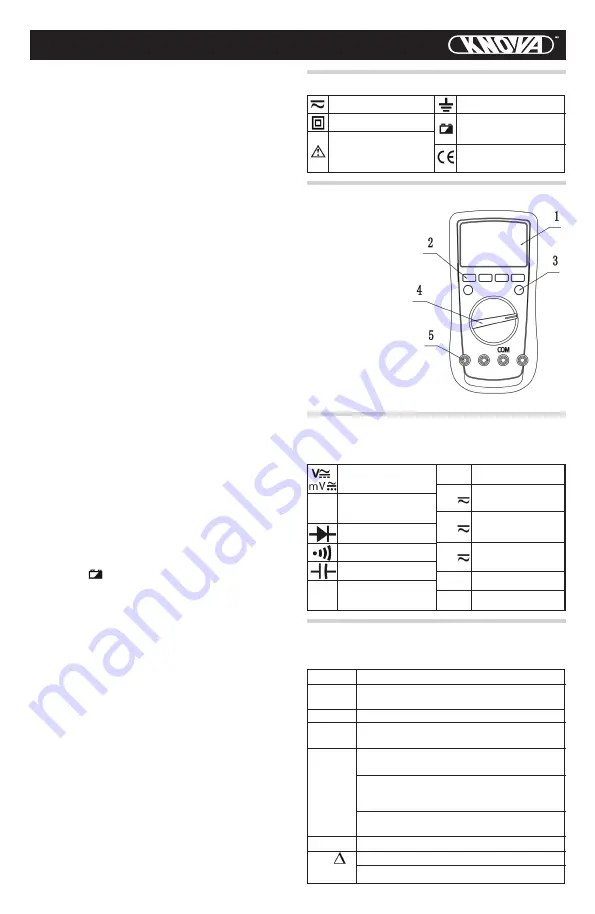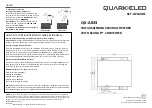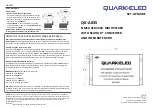
Rules for Safe Operation
2
• Before using the Meter inspect the case. Do not
use the Meter if it is damaged or the case (or part
of the case) is removed. Look for cracks or
missing plastic. Pay attention to the insulation
around the connectors.
• Inspect the test leads for damaged insulation or
exposed metal. Check the test leads for
continuity. Replace damaged test leads with
identical model number or electrical
specifications before using the meter.
• Do not apply more than the rated voltage, as
marked on the Meter, between the terminals or
between any terminal and grounding.
• The rotary switch should be placed in the right
position and no any changeover of range shall
be made during measurement is conducted to
prevent damage of the Meter.
• When the Meter working at an effective voltage
over 60V in DC or 30V rms in AC, special care
should be taken for there is danger of electric
shock.
• Do not use or store the Meter in an environment
of high temperature, humidity, explosive,
inflammable and strong magnetic field. The
performance of the Meter may deteriorate after
dampened.
• When using the test leads, keep your fingers
behind the finger guards.
• Disconnect circuit power and discharge all
high-voltage capacitors before testing
resistance, continuity and diodes.
• Before measuring current, check the meterís
fuses and turn off the current to be tested before
connecting the Meter to the circuit. After
connecting the circuit reliably, turn the current to
be tested on.
• Replace the battery as soon as the battery
indicator appears. With a low battery, the
meter might produce false readings that can
lead to electric shock and personal injury.
• When servicing the meter, use only the same
model number or identical electrical
specifications replacement parts.
• The internal circuit of the meter shall not be
altered at will to avoid damage of the meter and
any accident.
• Soft cloth and mild detergent should be used to
clean the surface of the meter when servicing.
No abrasive and solvent should be used to
prevent the surface of the meter from corrosion,
damage and accident.
• The Meter is suitable for indoor use.
• Turn the Meter off when it is not in use and take
out the battery when not using for a long time.
• Constantly check the battery as it may leak when
it has been using for some time, replace the
battery as soon as leaking appears. A leaking
battery will damage the Meter.
International Electrical Symbols
The Multimeter Structure (see figure 1)
Rotary Switch
AC or DC
Double insulated
Warning. Refer
to the operating
manual
1) LCD display
2) Functional buttons
3) Blue button
4) Rotary switch
5) Input terminal:
AC and DC voltage
measurement
Resistance
measurement
Diode test
Continuity test
Capacitance test
Frequency and
duty cycle test
Below table indicated for information about
the rotary switch positions.
Grounding
Deficiency of
built-in battery
Conforms to standards
of european union
figure 1
Transistor
DCA and ACA
measurement
DCmA and ACmA
measurement
10A DC and AC
measurement
Sensor test
OFF Power off
Ω
Hz %
hFE
10A
mA
µ A
OFF
EF
Functional Buttons
Below table indicated for information about
the functional button operations.
Operation Performed
Press and hold for 2 serconds to turn
the display backlight on or off.
Press to enter or exit data hold mode.
Press to select the alternate feature
• Press RANGE to enter the manual
ranging mode; the Meter beeps.
• Press RANGE to step through the
ranges available for the selected
function; the Meter beeps.
• Press and hold RANGE for 2 seconds to
return to autoranging; the Meter beeps
Press to select the maximum and minimum value.
• Press to enter REL mode.
• Press again to exit REL mode
Button
Hold
BLUE
button
RANGE
REL




































